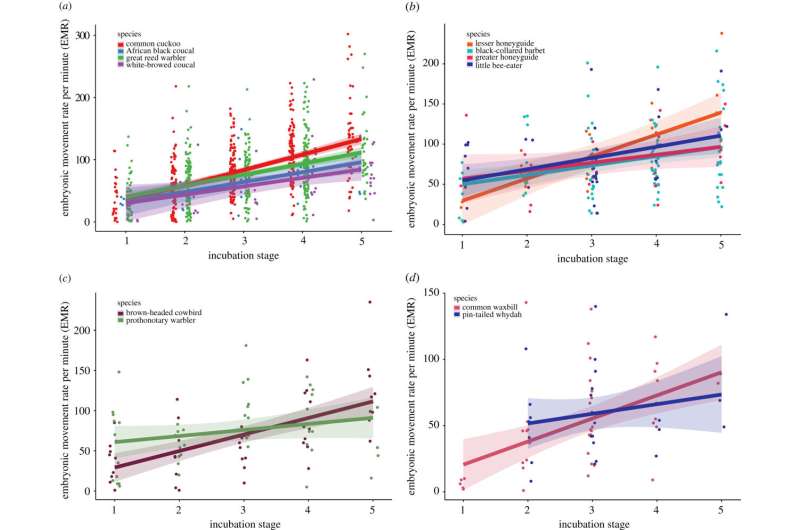Rate of embryo movement per minute (EMR) over the course of incubation for (a) common cuckoos, their great reed warbler hosts, and two non-parasitic cuckoos: African black coucals and white-browed coucals, (b) lesser honeyguides and their hosts (black-collared barbets) and greater honeyguides and their hosts (little bee-eaters), (c) brown-headed cowbirds and their hosts, prothonotary warblers and (d) pin-tailed whydahs and their hosts, common waxbills. (No measurements were available for pin-tailed whydahs at stage 1.) Shading indicates standard errors. Credit: DOI: 10.1098/rspb.2021.1137
An international team of researchers has found that some parasitic bird embryos move around more in their eggs than other species, which makes them stronger when they hatch. In their paper published in Proceedings of the Royal Society B: Biological Sciences, the group describes their study of multiple types of avian embryos and what they learned about them.
Parasitic birds lay their eggs in the nests of other species of birds. When the birds hatch, they try to kill the natural offspring to ensure they get more nutrition. In the example of the common cuckoo, the mother waits for a mother bird of another species to lay its eggs and then fly off to find food. The cuckoo swoops down and quickly lays an egg. When the natural mother returns, she nurtures the egg as if it were her own. The cuckoo embryo matures faster than the others in the nest and thus hatches earlier. Once hatched, the fledgling proceeds to push the other eggs out of the nest, ensuring it gets the full attention of the mother. Some who have witnessed the tiny chicks pushing eggs out of the nest have wondered how they have the strength to do it—it would be analogous to a newborn human pushing a bowling ball around.
The work by the team was conducted over many years. They collected 437 eggs from 14 bird species—some parasitic, some not—from multiple countries on different continents. Each of the eggs was then placed in a brooder and studied using what the researchers call an Egg Buddy, which is a device that shines a harmless laser into the egg and measures movement of the embryo.
In their studies, the researchers found that the parasitic embryos moved around in the egg more than the non-parasitic birds. The movement, the researchers found, made them stronger than they would be otherwise—strong enough to push eggs out of a nest, or for other types of parasitic chicks to push rival chicks out of the way at meal times, or in some cases, to maul or peck them to death.
More information: Stephanie C. McClelland et al, Embryo movement is more frequent in avian brood parasites than birds with parental reproductive strategies, Proceedings of the Royal Society B: Biological Sciences (2021). DOI: 10.1098/rspb.2021.1137
Journal information: Proceedings of the Royal Society B
© 2021 Science X Network






















